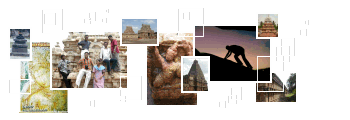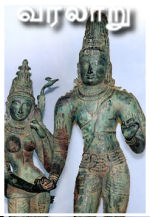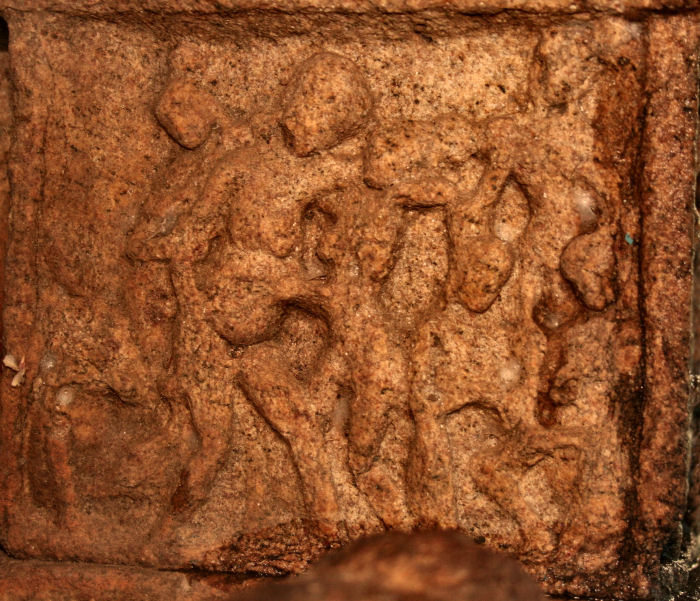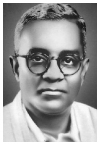 |
 |
 |
http://www.varalaaru.com A Monthly Web Magazine for South Asian History [187 Issues] [1839 Articles] |
 |
 |
 |
http://www.varalaaru.com A Monthly Web Magazine for South Asian History [187 Issues] [1839 Articles] |
|
Issue No. 106

இதழ் 106 [ ஏப்ரல் 2014] 
இந்த இதழில்.. In this Issue.. 
|
Series:
Chola Ramayana
The last panel in the Bhadra segment that houses Durga Devakoshta is a very interesting one as it represents a striking indigenous deviation from Rama’s story as gleaned from literatures. This panel also concludes Rama’s early adventures as a young prince (the Bala Kanda in literatures). The next series of panels proceed to represent his second phase of life – the coronation attempt and the aftermath.
This panel is fortunately in good condition and can be studied well. The theme is peculiar to Pullamangai and is not seen in any other early Chola narratives. From a sociological perspective, it provides a rare and exceptional glimpse at a labour room activities in Chola period. Pullamangai Panel No.28 – The Royal Delivery Location: North wall of the Mandapa, adjacent to the Vimana. Panel Segment: Vedipada in the Bhadra segment, facing East. Placement: Not significant. The panel is hidden from the eyes of the spectator facing Durga Devakoshta. Theme: A royal lady delivering a baby in a labour room, with the help of nurses and doctors. There are seven characters in this panel, all ladies. The main figure is a pregnant lady who is about to give birth to a baby. Her relative importance is emphasized by the relative placement, height and depth. She is in the front with two other supporting characters and the rest are all in the background. Since she is being assisted by several characters in her delivery, the suggestion is that she is a royal lady.  She is all nude and standing. Unlike modern times, babies were delivered with the mothers in standing position during Chola times - as represented in this panel. Because of the excruciating pain in the belly, she is unable to stand all by herself. Hence she is being supported by two nurses on either side. She is embracing one of them by putting her left arm around the nurse neck and leaning towards her – thereby pushing her weight to the left. Her right arm is held in her thighs. By providing sufficient depth, the sculptor highlights the pregnant woman’s chest and the belly. Her legs which are slightly placed apart are bending due to the excessive weight. She is about to give birth to a baby. The nurse standing to the left of the lady is fully receiving her weight and thrust. Her right hand is placed over the pregnant woman’s right shoulders, providing comfort and support while the left is held over the woman’s belly. She is probably trying to push the baby out of the belly by pressing. Her face is oriented towards the lady in full attention. Her legs, which are sculpted adjacent to the pregnant woman – are also bending due to the weight she is supporting. Her leg position complements that of the lady and the two are in movement – not static. She is the second important character in the panel. The tight embrace between the royal lady and this nurse suggests confidence and intimacy. The nurse standing behind the pregnant woman is tightly holding her right arm – thus preventing her from falling. Her face is oriented towards the right side. Three woman are seated on the ground – two to the left of lady and one to the right. The duo on the left are in conversation. They are the senior doctors (Maruthuvachis) probably discussing about the delivery that is in progress and preparing the necessary medicines that would be required immediately after the delivery. It is remarkable that neither of them are looking at the lady. The one seated to the right of pregnant lady is not clear in the sculpture. She should also be treated as a senior doctor supervising the delivery. In terms of relative importance, the three doctors come next to the pregnant lady and the nurses. All the three are seated in the ground – behind the lady giving birth. The last character is a servant who is about to leave the labour room. She is likely to be a messenger woman – whose task is to keep the anxious king and the world outside informed of what is happening in the labour room. This panel is a remarkable masterpiece and stands as a class apart in the entire early Chola Ramayana series in many respects. - The panel illustrates the great importance with which woman, especially the pregnant ones were held in Chola times. In this regard, we may consider several other panels from this period in which pregnant woman are highlighted and sculpted – such as the malasthana sculpture at Srinivasanallur. - The entire panel is not static but an extremely animatic representation of the many activities that happen in a labour room. Unless the sculptor himself had witnessed a royal delivery, it would be hard for him to imagine the process in such dramatic detail - The fact that the sculptor chose to highlight this theme in a series on Ramayana underscores the fact that this delivery is of great importance in the story he is narrating. It is noteworthy that in an earlier occasion (birth of Rama and other princes) the sculptors chose to highlight only the birth of babies – not the happenings in the labour room. The only plausible reason for this deviation is the relative importance of the pregnant lady in the narrative. Considering all the factors, above, we may conclude that the pregnant lady is none other than Seetha and the baby being delivered is Rama’s own offspring. The implications of this indigenous deviation are many. this is txt file� |

சிறப்பிதழ்கள் Special Issues 

புகைப்படத் தொகுப்பு Photo Gallery 
|
| (C) 2004, varalaaru.com. All articles are copyrighted to respective authors. Unauthorized reproduction of any article, image or audio/video contents published here, without the prior approval of the authors or varalaaru.com are strictly prohibited. | ||